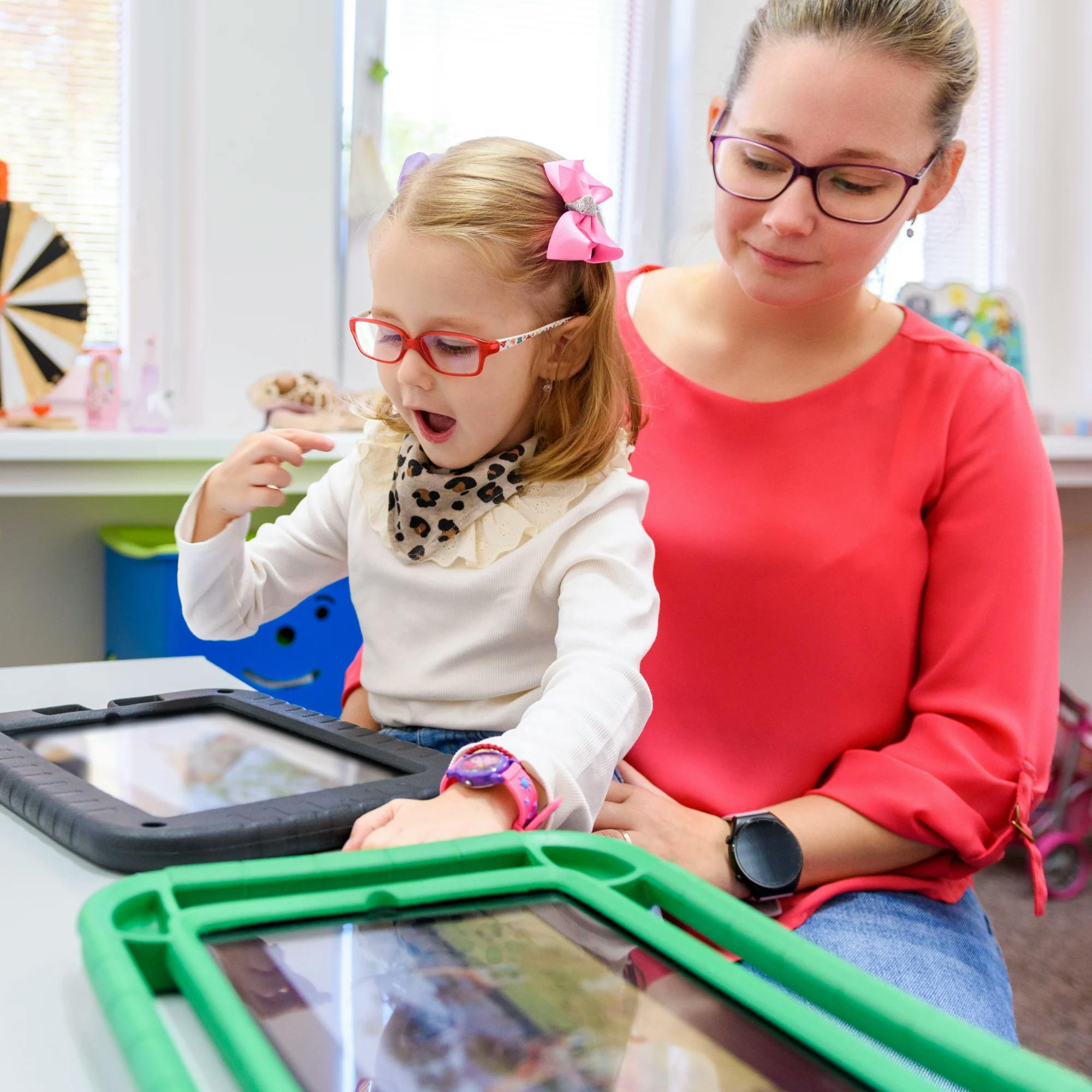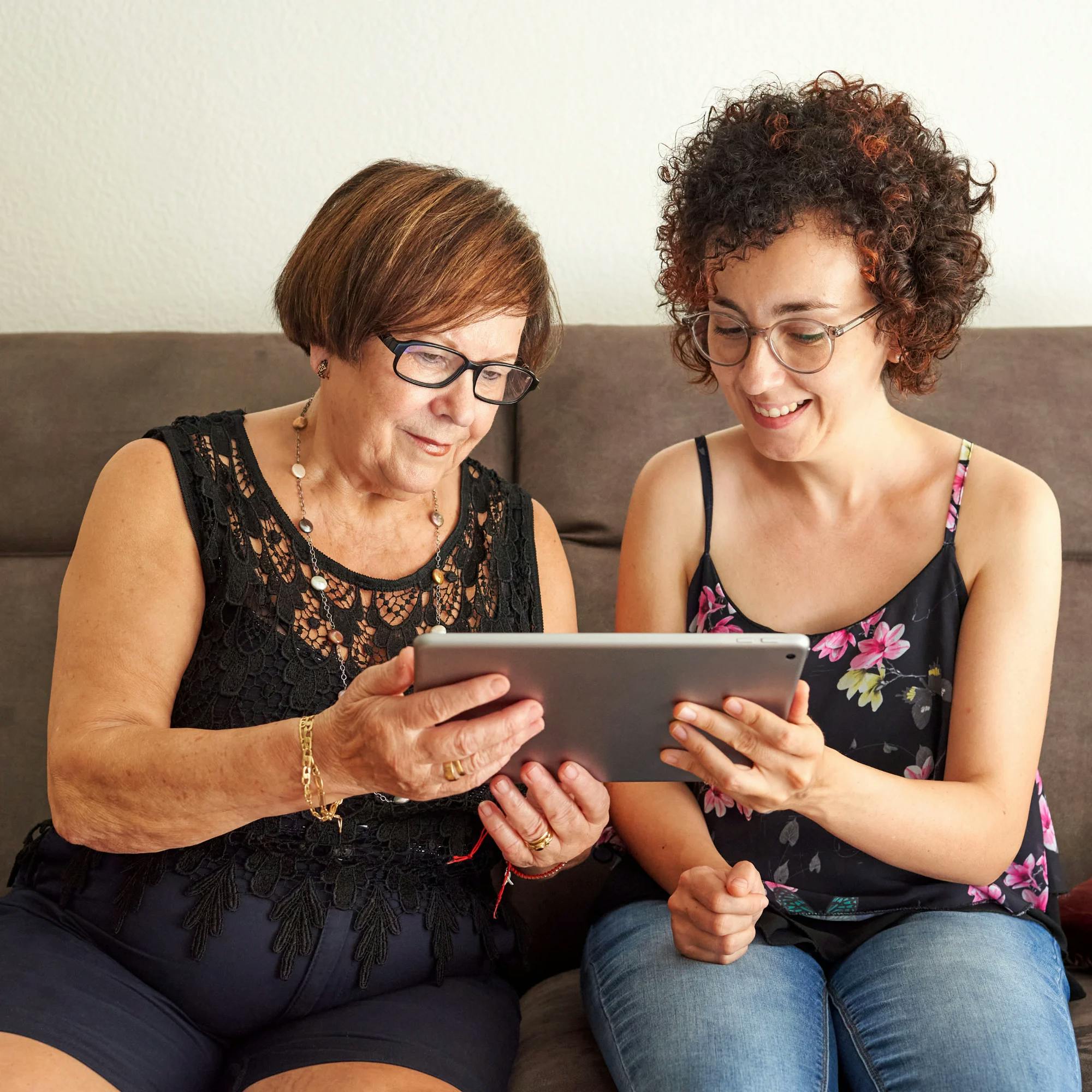An AAC device helps people who can’t rely on speech to communicate. “Augmentative and alternative communication” (AAC) is an umbrella term that covers many methods that either support or replace spoken communication. You might not know this, but you use AAC every day! Passing someone a note, waving goodbye, pointing to something, and giving a thumbs-up without speaking are all forms of AAC.
If you’re unable to communicate using speech, trying to express yourself can be frustrating. For these people and their loved ones, AAC can serve as their “voice”--and it can be life-changing.
Our speech therapists have put together this informative guide to help you understand the types of AAC devices available, how to choose the right AAC device, and how speech therapy can help people use AAC to communicate in everyday situations.
Find the right speech therapist for you
We'll match you with a speech therapist who's experienced in your area of need and available when you are.
 Get started
Get startedWhat is AAC?
AAC stands for augmentative and alternative communication. It’s any way of communicating other than talking. Any method that can help a person communicate counts as AAC. AAC includes many systems and devices, such as communication boards, speech-generating devices, computer apps, and picture books. It also includes “no-technology” techniques such as drawing or writing, gestures, facial expressions, and other nonverbal communication.
How does an AAC device help people communicate?
There are two categories of AAC: augmentative communication and alternative communication. Augmentative communication adds to someone’s speech. These are devices that support, supplement, or enhance your natural speech. One example: A portable amplifier that increases the volume of your speech when you’re in a loud place. Alternative communication is used instead of speech. Alternative communication devices replace your natural speech. They are helpful for a person who is unable to communicate verbally. For example, a voice output communication aid (VOCA) is a computer program that will say words out loud for you.
Ed's inspiring story
A brain injury almost took away this professor's voice, but speech therapy, new AI technology, and his own determination changed everything.
 Read Ed's story
Read Ed's storyWho can use an AAC communication device?
People of all ages can use AAC, from children who can’t yet read to older adults. People use AAC devices for a variety of reasons. The user may be limited in their speech, have difficulty producing or understanding language, or be completely nonspeaking.
Some people use AAC temporarily after surgery or a medical event, such as a stroke or brain injury, until their communication skills are restored. Some people use AAC long-term from childhood due to a diagnosis such as cerebral palsy or autism. While not a full list, people who can benefit from AAC may include those with:
Problems with language, cognition, or speech; voice disorders; apraxia of speech; aphasia; dysarthria; autism; or Down syndrome
Difficulty communicating their needs and wants; often experiencing “communication breakdowns”
Hearing problems
It’s important to note that if a child is using AAC, that doesn’t mean they can no longer learn to use spoken language. AAC use supports language development overall. Using a device can help children communicate their thoughts, ideas, wants, and needs while they’re developing the skills to talk.


Types and examples of AAC devices
Any method that can help a person communicate counts as an AAC device. There are three types of AAC devices: high-tech, low-tech, and no-tech.
1 High-tech AAC
High-tech AAC devices are digital technologies. Some examples of high-tech AAC include:
Apps on a tablet, such as an iPad
Computers with text-to-speech software
Devices with pre-recorded messages
Speech-generating devices (SGDs), which are a computer or an app with a voice
Amplifiers
A key aspect of high-tech AAC devices is that they are “dynamic.” Dynamic AAC devices can create on-the-spot messages to help the user immediately. They can be changed instantly as well.
A note about speech-generating devices: This type of AAC device is usually covered by insurance if deemed medically necessary and appropriate.


2 Low-tech AAC
Low-tech AAC devices are “static” systems. This means they can’t be changed and only have so many ways to display certain pictures or symbols. Examples of low-tech AAC systems include:
Communication boards
Picture books
Drawing tools
Picture symbols
3 No-tech AAC
No-tech AAC techniques have been around forever! Examples of no-tech AAC include:
Sign language
Body language
Facial expressions
Vocalizations

Ways to use a high-tech AAC device
There are many ways to use a high-tech AAC device other than pressing a button with your finger. These access methods may include the following:
Direct selection: Touching the screen or a button with a body part or a stylus.
Eye gaze: Technology that tracks your eye’s movement to select a button.
Head tracking: Technology that uses the intentional movement of your head to track what you want to select on the screen.
Switches or mouse control: A switch is a tool such as a button or mouse that you click to select a button. You can use this for scanning (see below) or along with another access method such as eye gaze.
Scanning: A device’s screen may “scan” through the buttons by highlighting one button at a time. Once the button you want is highlighted, you can click it using a switch.
EMG switch: These are switches that use electromyographic (EMG) signals by placing an electrode on a muscle in order to “click” the button on the screen you want to select.


Benefits of AAC communication
An AAC device is essentially the user’s voice. That’s why the user should bring their AAC device with them wherever they go. The benefits of using augmentative and alternative communication include:
Increased independence
Better mental health
Less frustration
More participation with family and friends
More positive social interactions
More employment opportunities


How can you get an AAC device?
There are many options when it comes to using AAC, so how do you know which type of AAC device is right for you? This is where speech therapists and representatives from AAC device companies can be extremely helpful. They are trained to evaluate the person’s specific needs and suggest appropriate AAC systems. Having an evaluation to select your AAC device is one of the most important steps in receiving a device. This article includes more details about the process of getting a speech-generating AAC device, but here’s an overview: 1. Talk with a speech therapist to discuss your options for AAC communication. There are several different companies that make AAC devices. 2. If an AAC device is decided to be appropriate for you, contact your health insurance to make sure a speech-generating device is a covered benefit. Talk with your doctor as well. You may need a prescription or documentation from them. 4. Schedule an AAC evaluation with your speech therapist to select the right device. 5. Once you select your device, you may need to fill out paperwork from the AAC company. The AAC company will send the paperwork to your insurance for approval. 6. If the AAC device is approved by your insurance, the AAC company will send you the device. Once you receive it, you can bring it to speech therapy and start learning to use it in sessions! If a speech-generating device is not an option, or for a quicker way to access AAC, some families download an AAC app on their iPad or other tablet. There are many to choose from, such as proloquo2go and TouchChat. This can also be a good communication system to use while waiting for your speech-generating device.


How does online speech therapy work for AAC users?
Expressable matches individuals and families with a licensed speech therapist trained to evaluate and treat speech and language disorders that require an AAC device. All therapy is delivered online via face-to-face video conferencing. Based on the client’s age, communication difficulties, and goals, the speech therapist will develop a personalized treatment plan to meet their needs. As explained above, before a person can receive an AAC device, they must have an AAC evaluation. Your speech therapist can collaborate with other professionals, including physical therapists and occupational therapists, to help determine the best AAC device for you or your loved one. Once the AAC device or system is chosen, the speech therapist can:
Teach the person how to use their AAC device
Teach family and friends how to communicate with the AAC user
Program the device so the AAC user can communicate effectively
Teach the AAC user and/or caregiver how to change the words on the device
Expressable’s approach to speech therapy with an AAC device is centered on caregiver involvement. Adult clients can choose to attend sessions by themselves, but are welcome to bring caregivers or family members along with them. Because sessions are online, loved ones can attend from wherever they are. For children, we recommend that a parent or caregiver attend sessions with their child so they can learn at-home strategies from the speech therapist. This way they can confidently practice with their child outside the session and improve their child's communication.


With an AAC device, there are a few other reasons for a parent or caregiver to attend sessions:
Family members should learn how to use the AAC device. When a person is first learning an AAC system, one of the main ways to support them is by modeling, or demonstrating, how to use the device. Here’s an example. Say the adult and child are blowing bubbles, and the adult wants to model language for the child. They may say, "Wow, it's bubbles! Pop pop pop!" and click on the icon for "bubbles," so the device says "bubbles” at the same time. This helps the child make the association between the actual physical bubbles and the bubbles icon on the device.
The caregiver can tell the speech therapist about the most important concepts, items, and people in the child’s life. The speech therapist can then show them how to program the device to put those things in easy-to-find places. For example, if the child loves playing with cars, the therapist would program "cars" on one of the main screens.
It’s helpful to learn the technical side of using the AAC device. The parent or caregiver is likely the one charging, updating, and otherwise managing the device throughout the week. Your speech therapist can help with this, as well.
Support beyond sessions: The Expressable portal
Speech therapy is a partnership between the client, family, and speech therapist. All Expressable clients have access to our client portal, so you can keep learning and practicing all week long. In the portal, you can access:
Learning Paths that explain and reinforce therapy strategies, such as tips for using your device
Demo videos that show real techniques in action with AAC devices
Home practice activities you can do during your everyday routine, like practicing with your device at a store or restaurant
Text messaging support, so you can ask questions, get reminders, or receive tips from your therapist between sessions
By using the tools in the portal and practicing regularly, your loved one can make faster progress in learning to communicate with AAC.
How to support your child or loved one who uses an AAC device
Below are some tips to help you support the AAC user in your life.
1 Know how to use the AAC device
As explained above, it’s important to understand how to use your loved one’s AAC system or device. If you don’t understand it, you won’t be able to respond to them. This will make communication between the two of you very challenging.
2 Show your child or loved one how to use the device
Demonstrating how to use the AAC device is the best way for your loved one to learn how to use it themselves.
3 Use AAC communication everywhere and with everyone
The AAC device is your loved one’s “voice.” Bring it everywhere with you, so the device becomes a familiar, common practice of communication for everyone involved. Remember, the goal of having an AAC device is to help the person communicate as independently as possible.


4 Reward your loved one for using their AAC device
It takes time to adjust to using an AAC device. To keep your child or loved one motivated and help them build the habit, try using reinforcements or small rewards, especially at the beginning. Try to keep communication fun and interesting! For example, when your loved one tries to use the device, turn your attention to them. Acknowledge their attempt, even if the actual message isn’t accurate. You can give your child a small physical reward, such as a toy or an activity.
Remember that many AAC users understand what's said to them. The device helps them communicate the thoughts, ideas, and feelings that are in their brain.
5 As a communication partner, be patient and go slow
At the beginning, focus on using AAC during activities that are already fun for your loved one, rather than in a high-pressure situation. If your child or loved one is acting out or seems confused or frustrated when they use the device, stop using it for a while and try something else. Remember, the AAC device is meant to help the user, not cause harm. When you’re speaking to your loved one, take your time. Repeat yourself as needed, and pause after sentences if they have trouble understanding you. This helps the AAC user process what you’re saying, which will make it easier for them to respond. Also, wait for them to be done communicating before taking your turn to speak. Remember that many AAC users do have strong receptive language, which means they understand what's being said to them. The device helps them communicate the thoughts, ideas, and feelings that are in their brain. They may know exactly what they want to say, but they need some time to use the device to get the message out. So be patient as they respond. The rhythm of the conversation may be a little different from what you’re used to, but that’s OK!
Reach out to Expressable
If your child or loved one is an AAC user, or you think you may need an AAC device, reach out to our talented team here at Expressable. We’ll match you with a licensed speech therapist who can explain your options, perform an AAC evaluation, or help you make the most of the device you have. Start our simple sign-up here!
How Expressable Can Help
Concerned your child isn't reaching age-expected milestones? Looking for communication support from a professional? Expressable is a national online speech therapy practice serving children and adults. We treat all major areas of communication and feeding, offer flexible hours including evenings and weekends, and accept most major health insurance plans. We’re proud to have earned more than 3,000 5-star reviews from our clients (4.9/5 average).
Our therapy model is centered on parent and caregiver involvement. Research proves that empowering caregivers to participate in their loved one’s therapy leads to better outcomes. That’s why we combine live, 1-on-1 speech therapy with personalized education and home practice activities for faster progress.
Communication is more than words. It’s how we share how we feel and show who we are. We’re here to help you or your child do just that.

 Abby Barnes, M.S., CCC-SLP
Abby Barnes, M.S., CCC-SLP










